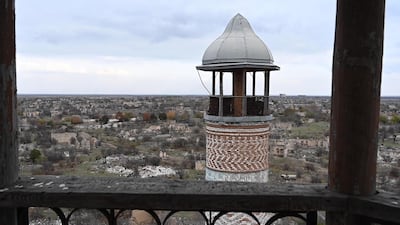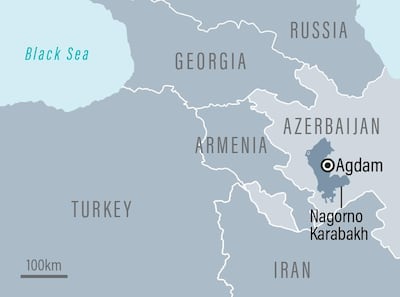The twin minarets of Agdam’s mosque are the only landmark that remain of a once-thriving town. Heaps of rubble now lie on streets where thousands used to live and the only sign of human activity is half a dozen masked Azerbaijani soldiers.
Some have described it as the Hiroshima of the Caucasus, and strong winds have whistled through the empty town on Azerbaijan’s western plains since 1993 when it was lost to Armenian separatists in the first Nagorno-Karabakh war.
Azerbaijanis long knew the town had been pillaged. After ethnic Armenians took control of Agdam in 1993, locals fled and soldiers pulled timber and bricks from the buildings and looted furniture. Thirty years later, and images of its condition on state TV have renewed fury.
The town was handed back to Azerbaijan on November 20, following a six-week war between Azerbaijan and Armenia over Nagorno-Karabakh and surrounding regions, during which almost 6,000 troops were killed.
The mountainous enclave lies within Azerbaijan but is largely populated by ethnic Armenians and its status has been contested since Soviet times. War first broke out in 1988, and six years of fighting saw Armenians take control of much of the enclave.
A Russian-brokered ceasefire has largely bought the recent fighting to an end. The outcome was a resounding victory for Baku, placing much of Nagorno-Karabakh under its control, as well as returning the nearby regions that were occupied by Armenia in the last war. The deal was probably all that saved Armenian forces from a complete rout and the loss of the disputed region’s main city – Stepanakert.
Now, 2,000 Russian peacekeepers patrol the line of contact, and they have a mandate to do so for five years.
In December, captured Armenian tanks were paraded through the streets of Baku in victory celebrations attended by Turkish President Recep Tayyip Erdogan – Azerbaijan’s closest ally. The euphoria lingers long after Mr Erdogan left; a bus rides along the seafront boulevard with “Karabakh is Azerbaijan” scrolling across its ticker, while even the labels of plastic water bottles are plastered with a banner proclaiming victory.
Azerbaijan once hosted a thriving Armenian community – perhaps as many as half a million people – but that population has withered over the years. Pogroms in the 20th century and the outbreak of the first war over Nagorno-Karabakh sent many fleeing to Armenia. Although the Azerbaijani government claims more than 30,000 Armenians continue to live peacefully here, it is difficult to find any trace of them.
On a Sunday in December, The National found the capital’s only Armenian church to be shuttered. A government official offered to arrange a visit, but there was little sign of a community – many of the Armenians who remained in Azerbaijan converted to Islam and married into Azerbaijani families. If they remain, their Armenian identity is hard to see.
Despite this, Azerbaijan’s government has repeatedly said it considers Armenians from Nagorno-Karabakh and the surrounding regions its citizens. It even claims it wants to bring Armenians back into the fold.
Hikmet Hajiyev is an adviser to Azerbaijan's President Ilham Aliyev. He was, in many regards, the face of the country’s war. His Twitter feed served to announce military gains and he made Azerbaijan’s case for war to the international community. Now he is pitching reconciliation.

“We are acknowledging them as citizens of Azerbaijan. We are ready to provide all constitutional rights to these people, including economic and social benefits,” he tells The National.
“For the security concerns, we have Russian peacekeepers, to an extent they can also provide safety and security.”
Away from the war, there appears to be good reason for Armenians to be sceptical of this paternalism.
In 2004, an Azerbaijani officer posted to Hungary on a Nato training programme killed an Armenian colleague with an axe while he slept. After eight years in jail, Ramil Safarov was extradited to Baku on assurances it would be where he served the rest of his sentence. He was instead pardoned by President Aliyev and received a hero’s welcome, as well as years of back pay.
Mehman Huseynov, an activist whose videos on government corruption have previously landed him in jail, says the government regularly labels critics like him “Armenians” – deploying it as a slur almost equivalent to traitor.
“They use it to slander people here,” he says.
To add to the distrust between the two communities, evidence continues to emerge of war crimes on both sides during the recent conflict – from the use of extrajudicial killings to beheadings.
Baku insists the incidents on its side are isolated cases, and that any Azerbaijani soldiers found to have committed such acts will be brought to justice. Indeed, last month, authorities charged four soldiers with war crimes – the first such arrests on either side.
“It’s unacceptable, I condemn [this behaviour]. It’s beyond Azerbaijani culture. Perpetrators will be severely punished under Azerbaijani laws,” says Mr Hajiyev.

Yet beyond the rhetoric, there is scant evidence of efforts to reassure Nagorno-Karabakh’s ethnic Armenians that they might have a future as Azerbaijani citizens. There are no grants to entice Armenians back, and several requests from the cultural organisation Unesco to visit and assess Armenian heritage sites now under Azerbaijan’s control have been ignored.
“They don’t have a mechanism. Without a mechanism you cannot convince people that they should be your citizens,” says Anar Mammadli, a human-rights activist and election monitor who was jailed by Mr Aliyev's government for two-and-a-half years.
“We should understand that we have two options. To prolong this conflict or to start a reconciliation process. For reconciliation, we can’t repeat the mistakes of humiliation [of our enemies] and glorification [of victory].”
“We cannot translate this victory into a problem for the next generation,” he says, hinting at the pain many Azerbaijanis still describe when talking about the losses of the first war.
While thousands have returned to the parts of Nagorno-Karabakh still under Armenian control, many are staying away. A senior aid worker in Stepanakert said the number of Armenians returning to live under areas passed to Azerbaijani control was “virtually nil”.
While President Aliyev has been accused of stoking the conflict to distract from his previously waning popularity and a faltering economy, activists say the Nagorno-Karabakh issue is deep within Azerbaijan's national identity.
“It doesn’t matter who comes to power, they [the people] will demand the de-occupation of Nagorno-Karabakh,” said Rasul Jafarov of the Baku Human Rights Club, co-winner of the prestigious Sakharov prize in 2014, which honours those who have dedicated their lives to the defence of human rights and freedom of thought.
Mr Hajiyev insists that the areas of Nagorno-Karabakh that remained under Armenian control under the ceasefire, such as Stepanakert, the seat of the self-declared independent government of Artsakh (the name given to the territory by Armenians), will one day be returned to Baku.
“We are looking at a model of economic and political-economic reintegration to introduce them into the wider political and constitutional framework of Azerbaijan because, for us, territorial integrity is a fundamental principle,” he says.
“No peacekeeping mission is eternal or permanent.”
The Artsakh administration says it has no plans to submit to Azerbaijan’s authority; nor do the Armenians of Stepanakert.
Alongside these starkly different interpretations of the Russian ceasefire, Baku continues to arouse distrust by denying that foreign mercenaries fought on its behalf during the war, despite a heavy body of evidence suggesting otherwise. The intensity of the rhetoric around victory and the defeat of Armenians also arouses fears.
During the victory parade in Baku, Turkey's president alluded to the memory of Enver Pasha, an Ottoman officer who led the expulsion of the Bolsheviks from Baku. But for historians in Armenia and elsewhere, Pasha was one of the chief architects of the Armenian genocide, an event Azerbaijan and Turkey continue to refuse to recognise.
Nojal Qasimov served as a mayor in the district of Fizuli from 1992 to 1993, before it was lost to Armenia in the first war. Despite being displaced from his home town, he has been left at the bottom of housing and employment lists due to his opposition to President Aliyev. A portrait of his son Saad in front of the Azerbaijani flag is the only decoration on the bare walls of his modest family living room in the capital’s suburbs.
Yet while he lived through the first Nagorno-Karabakh war as a young man and fought on the front lines, he spent last year’s conflict anxious about his own son. It ended in personal tragedy – Saad was killed while fighting in September.
“If we had a democratic regime in Baku and a democratic regime in Yerevan, we could have solved this peacefully,” he says, longing for a lasting solution to the conflict.
“Now, I’m just waiting for the next war.”














